#palindrome number program
Explore tagged Tumblr posts
Text
Strange way of drawing the Dragon Curve
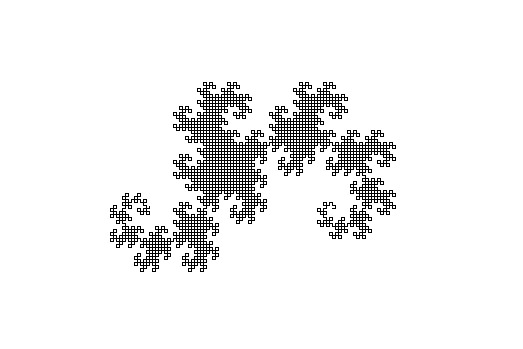
Alright, so real quick I just want to share potentially the most arcane method of drawing the Dragon Curve I've ever seen, derived and designed by yours truly! As far as I know, this is a novel solution. I know the sequence it generates is known, but I'm not sure if anyone else has used this method before. Its quite elegant if I may say so myself.

So for those that aren't aware in programming the "<<" and ">>" operators are sometimes known as "bit shifts." Basically what this is doing is starting at some number, adding a power of two, then getting a specific 1 or 0 in the binary representation of that number iteratively, until its searched enough bits to know they aren't going to change anymore.
It has to do with this sequence right here. I've mentioned before, my personal favorite way of generating the dragon curve is to start with the sequence 0, reverse it, add one, roll over once you reach 4, and tack that on to the original sequence. So 0 0 1 0 1 2 1 0 1 2 1 2 3 2 1 0 1 2 1 2 3 2 1 2 3 0 3 2 3 2 1 Well what ends up happening is each time you add one, its like adding one to the reversed part of the newly added sequence. So we can track where all these 1's come from based on when they're added. For example, the 1 we added in the "01" step turns into 0 1 0 1 1 0 0 1 1 0 0 1 1 0 Note from here on out its palindromic, so reversing it no longer has any effect. What we end up with is a repeating pattern of two 1's, then two 0's, starting with half that many 0's. When going from 0 1 0 1 2 1 We're adding 1's to the entire second half, so in this step the 1's propagate to 0 0 1 1 0 0 1 1 1 1 0 0 0 0 1 1 1 1 0 0 0 0 1 1 1 1 0 0 And again, this is now palindromic. Four 1's, four 0's led by half that many. One of the things I've learned about the dragon curve is just how intrinsically linked it is to binary (and this makes sense when you think of the folding paper method of generating it. Here's an excel spreadsheet demonstrating this in action
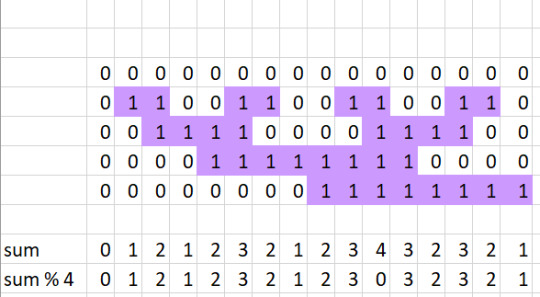
Now here's the fun part. My research was to parallelize this algorithm. One approach is to say "Okay, how can we calculate each term in this sequence without looking at the previous ones." And the answer is to exploit these very predictable patterns. And how do we predict these patterns? Simple, we simply count in binary
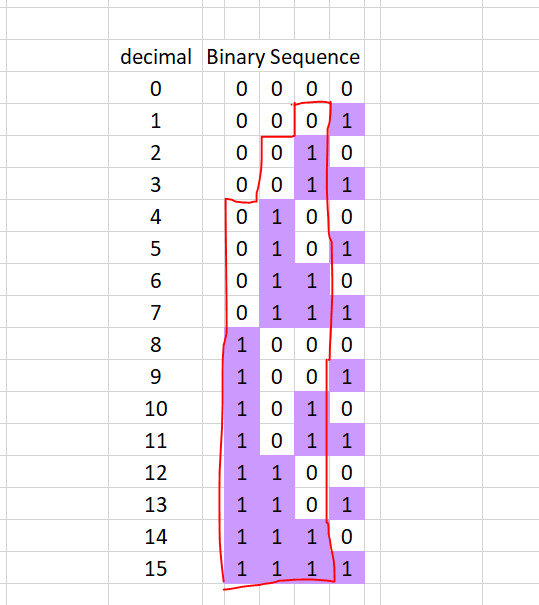
The right most column is useless, but starting at the next one to the left, we see a familiar pattern, almost. Say we want to know what the 5th number in the dragon curve sequence is (0 indexed). To make the sequence only lead with one 0 instead of two, we need to offset by 1, then all we have to do is increase the number by (n + 1) = 5 and take its 2nd least significant bit (1 indexed because english). The 2nd bit of ( 1 + 5 = 6 ) is a 1. For the next iteration we're looking at the 3rd least significant bit. Here we need to offset by 2, and then we increase the number by 5 again and the 3rd significant bit is the one we take. The 3rd bit of (2 + 5 = 7) is another 1 After that we're looking at the 4th least significant bit. We need to offset by 4, then increase the number by 5, and the 4th significant bit will give us our number. The 4th bit of (4 + 5 = 9) is going to be another 1, bringing our total to 3. Here's a visual representation
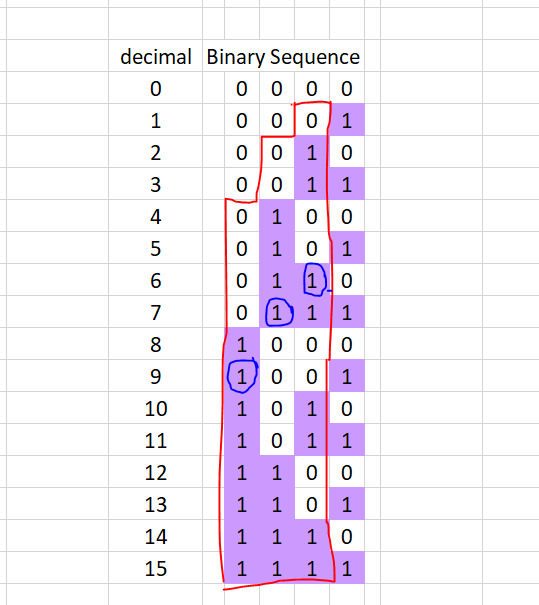
This is where the "1 << i" comes in, because that's the same as saying 2^i, which is how we get those offsets of 1, 2, 4, then 8, 16, 32... the "n" in "n + (1 << i)" comes from us offsetting to get the nth term in each sequence Finally the " >> (i + 1) " and "% 2" are to fetch the (i + 1)th bit from the number. After that the increasing size of the leading zero's outpaces our constant offset of the number 5, so we are only going to get 0's from here on out, and we can actually stop, hence the usage of bit length to terminate the loop early.
And if we look at the the 5th element of the sequence (0 indexed) 0 1 2 1 2 3 Funnily enough, in python this brings an actual speed increase (or at least, distributes the cost over the drawing) because of how slow reading and writing to memory is, compared to how math and bit-wise operations are implemented in low level C behind the scenes. Additionally, since there is no reliance on previous work this task can be multi-threaded, or even GPU accelerated if need be. Finally, if you've made it this far, here are a few images of some close ups of dragon curves from my GPU implemented (unrelated to this one entirely) just so that there's something pretty. Enjoy <3


#Dragon curve#fractal#programming#progblr#codeblr#python#fractals#math#computer science#algorithms#binary
126 notes
·
View notes
Text
This segment was once a long meandering tangent disparaging the fact that the community i once held dear was completely dead, and yet it's still stuck in my mind like some cancerous fucking tumor. But times change, over the course of the past two months we've slowly built up a community of thriving players, and instead all I'm going to say is,
you should play MsPaint risk (and join our discord @ https://discord.gg/Kd2ZJcpQPY )
The thing about MsPaint risk is like. How do you even begin to describe something that has almost infinite possibilities contained within it. It’s not a game, so much as it is a system, a culture, and a history of at this point well over a decade, spanning over several platforms and having had hundreds of active players over the course of its history. Naturally, you can start with the fundamentals. MSpaint risk is, at its core, a map game - map system. But that core is so simple it’s almost stupid. Imagine this: You open a paint program,
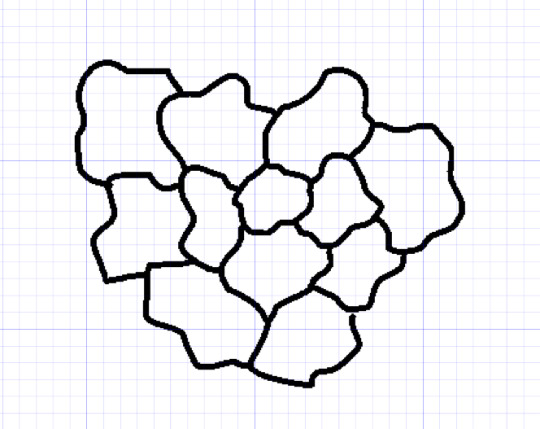
And draw a couple interconnected rectangles.
You decide to bring in two friends, and tell them to pick a color, a rectangle to start out on, and a color.
You tell them to roll two dice and give you the resulting sum of the numbers, and you say that: if your sum is between 1 and 4, i’ll give you 1 rectangle, between 5 and 10 i’ll give you two rectangles and if you roll an 11 or 12 i’ll give you 3 rectangles.
Congratulations! You’ve just made your first risk map, in about thirty seconds. Simple, right? But this is a bit fucking boring. First off, with that amount of tiles, the game - turn based in 99% of cases - will be over extremely quickly. And even if there were more tiles:

Even, alot more tiles:

You still have the issue of the game you’ve created being entirely luck based.
So, what do you do?
You zoom out, and realize that the world is in your hands.
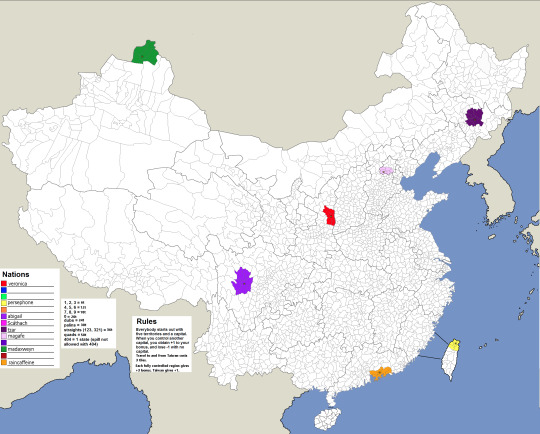
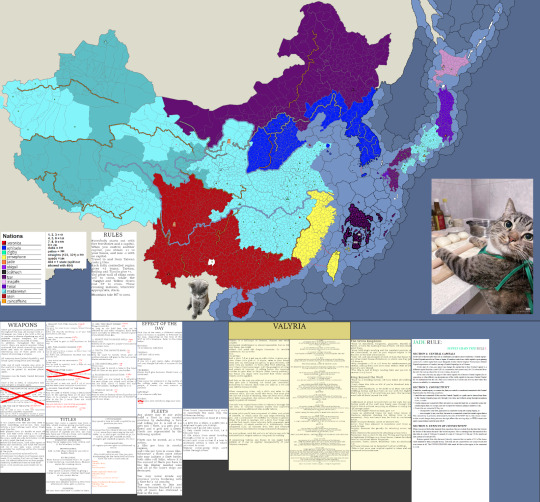

The above game started as a blank slate, where we more or less only had one rule to start out with, apart from the basics:
Each time you roll repeating digits or a palindrome, you may propose one change to the map or rules, as long as it doesn't give you an advantage over the other players. The game went on for 32 turns in total, over the course of a month, and during that month we constantly changed the fabric of the game - just because we told ourselves that this is what we wanted to do. All the rules were written by us, and implemented by us - drawn by us. Now, naturally, this is a bit of a special example, as normally games follow a set of rules defined clearly before the game starts, but I think it illustrates my point- that risk is a game of infinities. And you, too, can join us in future games:
Fundamentally, though, MsPaint risk is a game where the players are in control over everything. There are no limits, no rules, simply imagination, and self-imposed boundaries that lead to self-curated experiences. You are in control, and if you so choose it, you can create whatever you want - as long as what you create is something that other players want to play.
I first found the game in late 2016, and ever since then, its completely captured me. I’m serious when I say that I’ve never found anything quite like it - no other game that simply gives you a blank slate and asks you to go wild with your creativity. Over the years, as you might imagine from my rambling, I’ve tended to gravitate towards mapmaking, experimenting and finding what tropes work, and which don’t. But naturally play comes first;
we host an archive of over 2000 unique maps where each one was at one point hand made by a person with the intent to make a fun experience, whatever that entailed for them at that point. But it is exactly this that makes MsPaint risk so unique - no map is alike. All of them are different, and appeal to different demographics, and people.
You might want to torture yourself and your fellow players by playing something that’s more akin to a game of civilization than anything else:



Or maybe you want something more casual, where you can flex your people skills and make alliances with other players:

Maybe you want to roleplay, and imagine yourselves in Gensokyo, or space, or the mass effect universe:
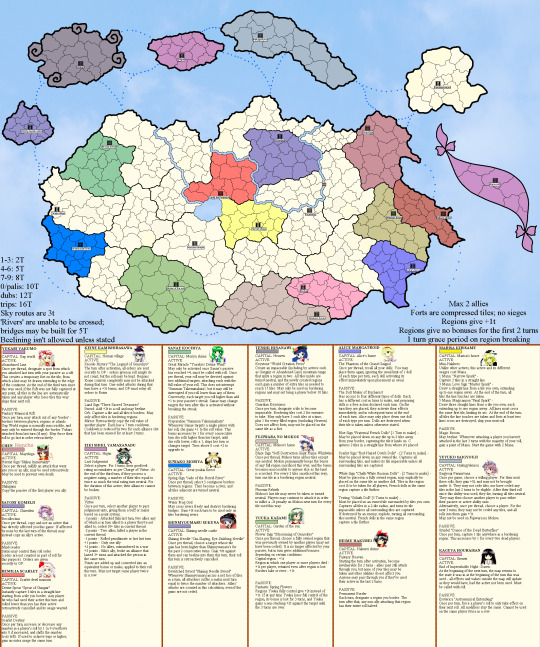


Whatever you choose to do, there are no limits, apart from the ones you set yourself. Over the past two months we've been building up a community of like-minded people who all love the game, and want to see it thrive. If anything in this post has piqued your interest or made you want to learn more about the game, or even try it, i again highly encourage you to join our community. We have constant games going, and tend to cycle in new ones every 1-2 weeks on average, so even if nothing of what we have got going right now is of interest to you, I promise we'll eventually get to something for you.
As a sendoff, here's a small collection of maps we've hosted in the past 2 months:



I hope I'll see you in the server, and if not, I hope I at the very least enlightened you to why this game means so much to me - and why it has utterly consumed me for a good chunk of my life.
3 notes
·
View notes
Text
A Toughie
Today's programming problem was "for a string, return all the lists of partitioned substrings that only contain palindromes."
So for instance, if your string is "ama":
['a', 'm', 'a'] ['a', 'ma'] ['am', 'a'] ['ama']
You want it to return the individual letters because that's always a palindrome and you want it to return the full-length word because that happens to be a palindrome too. But if you cut it up in a way that includes "am" or "ma" as their own strings you throw out that list.
At first I looked up a recursive algorithm for partitioning a string in all possible combinations, and used that to generate my list of lists, and then I went through and cut all the lists that contained non-palindromes. And sure, I cut as efficiently as possible (immediately rejecting the list once I found one fail, rather than continuing to look through the list), but there was still a big inefficiency in the fact that I was generating the entire list-of-lists before I started to filter.
The problem says the starting string can be up to 16 characters long.
The number of ways you can chop up a string of n characters is 2^(n-1). So a 16-character string produces 32,768 lists to be filtered.
So I had a solution pretty quick: generate, then filter. But I wanted a good solution. I kept fiddling with the recursive loop that was producing my list in the first place, until at last I found where it was adding new strings to the list. And I set it up so that if the new string wasn't a palindrome the program gave up on the whole list-of-strings it was working on and started on the next.
So when I put in "racecar" it doesn't start by generating 64 lists. It only generates the four correct answers in the first place:
['r', 'a', 'c', 'e', 'c', 'a', 'r'] ['r', 'a', 'cec', 'a', 'r'] ['r', 'aceca', 'r'] ['racecar']
I am very pleased with this outcome. I'm glad I had a way to make a stopgap measure if I couldn't fix the problem, and I'm glad I knew there was a problem, and I'm glad I knew roughly what needed to happen to fix it, and how to test my ideas, and above all I'm glad I found a solution better than my stopgap in about another 15-20 minutes.
3 notes
·
View notes
Text
Exercise to do with python :

Write a Python program to print "Hello, World!"
This is a basic Python program that uses the print statement to display the text "Hello, World!" on the console.
Write a Python program to find the sum of two numbers.
This program takes two numbers as input from the user, adds them together, and then prints the result.
Write a Python function to check if a number is even or odd.
This exercise requires you to define a function that takes a number as input and returns a message indicating whether it is even or odd.
Write a Python program to convert Celsius to Fahrenheit.
This program prompts the user to enter a temperature in Celsius and then converts it to Fahrenheit using the conversion formula.
Write a Python function to check if a given year is a leap year.
In this exercise, you'll define a function that checks if a year is a leap year or not, based on leap year rules.
Write a Python function to calculate the factorial of a number.
You'll create a function that calculates the factorial of a given non-negative integer using recursion.
Write a Python program to check if a given string is a palindrome.
This program checks whether a given string is the same when read backward and forward, ignoring spaces and capitalization.
Write a Python program to find the largest element in a list.
The program takes a list of numbers as input and finds the largest element in the list.
Write a Python program to calculate the area of a circle.
This program takes the radius of a circle as input and calculates its area using the formula: area = π * radius^2.
Write a Python function to check if a string is an anagram of another string.
This exercise involves writing a function that checks if two given strings are anagrams of each other.
Write a Python program to sort a list of strings in alphabetical order.
The program takes a list of strings as input and sorts it in alphabetical order.
Write a Python function to find the second largest element in a list.
In this exercise, you'll create a function that finds the second largest element in a list of numbers.
Write a Python program to remove duplicate elements from a list.
This program takes a list as input and removes any duplicate elements from it.
Write a Python function to reverse a list.
You'll define a function that takes a list as input and returns the reversed version of the list.
Write a Python program to check if a given number is a prime number.
The program checks if a given positive integer is a prime number (greater than 1 and divisible only by 1 and itself).
Write a Python function to calculate the nth Fibonacci number.
In this exercise, you'll create a function that returns the nth Fibonacci number using recursion.
Write a Python program to find the length of the longest word in a sentence.
The program takes a sentence as input and finds the length of the longest word in it.
Write a Python function to check if a given string is a pangram.
This function checks if a given string contains all the letters of the alphabet at least once.
Write a Python program to find the intersection of two lists.
The program takes two lists as input and finds their intersection, i.e., the common elements between the two lists.
Write a Python function to calculate the power of a number using recursion.
This function calculates the power of a given number with a specified exponent using recursion.
Write a Python program to find the sum of the digits of a given number.
The program takes an integer as input and finds the sum of its digits.
Write a Python function to find the median of a list of numbers.
In this exercise, you'll create a function that finds the median (middle value) of a list of numbers.
Write a Python program to find the factors of a given number.
The program takes a positive integer as input and finds all its factors.
Write a Python function to check if a number is a perfect square.
You'll define a function that checks whether a given number is a perfect square (i.e., the square root is an integer).
Write a Python program to check if a number is a perfect number.
The program checks whether a given number is a perfect number (the sum of its proper divisors equals the number itself).
Write a Python function to count the number of vowels in a given string.
In this exercise, you'll create a function that counts the number of vowels in a given string.
Write a Python program to find the sum of all the multiples of 3 and 5 below 1000.
The program calculates the sum of all multiples of 3 and 5 that are less than 1000.
Write a Python function to calculate the area of a triangle given its base and height.
This function calculates the area of a triangle using the formula: area = 0.5 * base * height.
Write a Python program to check if a given string is a valid palindrome ignoring spaces and punctuation.
The program checks if a given string is a palindrome after removing spaces and punctuation.
Write a Python program to find the common elements between two lists.
The program takes two lists as input and finds the elements that appear in both lists.
15 notes
·
View notes
Text
C#: 100 Simple Codes

C#: 100 Simple Codes
beginner-friendly collection of easy-to-understand C# examples.

Each code snippet is designed to help you learn programming concepts step by step, from basic syntax to simple projects. Perfect for students, self-learners, and anyone who wants to practice C# in a fun and practical way.
Codes:
1. Print Hello World
2. Add Two Numbers
3. Swap Two Numbers
4. Check Even or Odd
5. Find Factorial of Number
6. Fibonacci Sequence
7. Check Prime Number
8. Find Max of 3 Numbers
9. Simple Calculator
10. Check Positive, Negative or Zero
===
11. Sum of Numbers in an Array
12. Reverse a String
13. Count Vowels in String
14. Check Palindrome
15. Find Minimum in Array
16. Check Leap Year
17. Print Multiplication Table
18. Simple For Loop
19. Simple While Loop
20. Simple Do-While Loop
===
21. Check if Number is Prime (Function)
22. Find Length of String
23. Convert String to Uppercase
24. Convert String to Lowercase
25. Find Power of a Number
26. Find Square Root
27. Check if Character is Digit
28. Check if Character is Letter
29. Reverse an Integer
30. Check Armstrong Number (3-digit)
===
31. Check if Number is Even (Using Function)
32. Find Average of Array Elements
33. Simple Menu with Switch Case
34. Find the Largest Element in Array
35. Simple String Concatenation
36. Check if Array Contains a Value
37. Sort Array Elements
38. Count Occurrences of Character in String
39. Use Ternary Operator
40. Simple Try-Catch for Error Handling
===
41. Convert Integer to String
42. Convert String to Integer
43. Check if String is Null or Empty
44. Check if String is Null or Whitespace
45. Use Math.Round()
46. Use Math.Floor()
47. Use Math.Ceiling()
48. Generate Random Number
49. Use foreach with Array
50. Convert Celsius to Fahrenheit
===
51. Convert Fahrenheit to Celsius
52. Check if Number is Positive
53. Check if Number is Negative
54. Convert Char to ASCII
55. Convert ASCII to Char
56. Print Even Numbers from 1 to 20
57. Print Odd Numbers from 1 to 20
58. Check if Character is Uppercase
59. Check if Character is Lowercase
60. Find Sum of Digits
===
61. Factorial Using Recursion
62. Reverse a Word Using Loop
63. Find GCD of Two Numbers
64. Find LCM of Two Numbers
65. Find First N Fibonacci Numbers
66. Replace Character in String
67. Find Maximum of Two Numbers Using Function
68. Swap Two Numbers Using Temp Variable
69. Swap Two Numbers Without Temp
70. Simple Calculator (Add, Subtract, Multiply, Divide)
===
71. Count Words in a Sentence
72. Check Palindrome (String)
73. Check Leap Year
74. Display Current Date and Time
75. Add Days to Current Date
76. Check if Number is a Perfect Number
77. Check if Number is Palindrome
78. Count Vowels in a String
79. Reverse Array
80. Print Multiplication Table
===
81. Check if Number is Armstrong
82. Find Power of a Number
83. Print Numbers Using While Loop
84. Print Numbers Using Do-While Loop
85. Use Switch Case
86. Find Max in Array
87. Find Min in Array
88. Count Even and Odd in Array
89. Print Star Triangle
90. Print Inverted Star Triangle
===
91. Check if Character is a Digit
92. Check if Character is a Letter
93. Check if String Contains a Word
94. Join Array of Strings
95. Split String into Words
96. Check if Number is Prime
97. Print Characters of a String
98. Remove All Spaces from String
99. Count Occurrence of a Character
100. Simple Login Check
===
0 notes
Video
youtube
leetcode 9 : palindrome number : java solution
LeetCode Problem 9, titled "Palindrome Number," asks you to determine whether an integer is a palindrome without converting the integer to a string. This problem assesses your ability to manipulate integers and understand number properties. The solution requires reversing part of the number and comparing it with the other half to check for symmetry, thus avoiding extra space that string conversion would entail. It tests edge cases like negative numbers (which aren't palindromes) and single-digit numbers. This challenge is excellent for beginners to strengthen their understanding of loops and conditionals in a programming context, particularly in Java.
0 notes
Text
CSE3040: Java Programming Midterm Project 1
Write a Java code for each problem. Make sure your program satisfies all specified requirements. When an example result is given, output of your program should match the result. Problem 11 (20 points) A palindrome is a word, number, phrase, or other sequence of characters which reads the same backward as forward, such as madam and racecar (from wikipedia). In this problem, you will write a…
0 notes
Text
hi
Longest Substring Without Repeating Characters Problem: Find the length of the longest substring without repeating characters. Link: Longest Substring Without Repeating Characters
Median of Two Sorted Arrays Problem: Find the median of two sorted arrays. Link: Median of Two Sorted Arrays
Longest Palindromic Substring Problem: Find the longest palindromic substring in a given string. Link: Longest Palindromic Substring
Zigzag Conversion Problem: Convert a string to a zigzag pattern on a given number of rows. Link: Zigzag Conversion
Three Sum LeetCode #15: Find all unique triplets in the array which gives the sum of zero.
Container With Most Water LeetCode #11: Find two lines that together with the x-axis form a container that holds the most water.
Longest Substring Without Repeating Characters LeetCode #3: Find the length of the longest substring without repeating characters.
Product of Array Except Self LeetCode #238: Return an array such that each element is the product of all the other elements.
Valid Anagram LeetCode #242: Determine if two strings are anagrams.
Linked Lists Reverse Linked List LeetCode #206: Reverse a singly linked list.
Merge Two Sorted Lists LeetCode #21: Merge two sorted linked lists into a single sorted linked list.
Linked List Cycle LeetCode #141: Detect if a linked list has a cycle in it.
Remove Nth Node From End of List LeetCode #19: Remove the nth node from the end of a linked list.
Palindrome Linked List LeetCode #234: Check if a linked list is a palindrome.
Trees and Graphs Binary Tree Inorder Traversal LeetCode #94: Perform an inorder traversal of a binary tree.
Lowest Common Ancestor of a Binary Search Tree LeetCode #235: Find the lowest common ancestor of two nodes in a BST.
Binary Tree Level Order Traversal LeetCode #102: Traverse a binary tree level by level.
Validate Binary Search Tree LeetCode #98: Check if a binary tree is a valid BST.
Symmetric Tree LeetCode #101: Determine if a tree is symmetric.
Dynamic Programming Climbing Stairs LeetCode #70: Count the number of ways to reach the top of a staircase.
Longest Increasing Subsequence LeetCode #300: Find the length of the longest increasing subsequence.
Coin Change LeetCode #322: Given a set of coins, find the minimum number of coins to make a given amount.
Maximum Subarray LeetCode #53: Find the contiguous subarray with the maximum sum.
House Robber LeetCode #198: Maximize the amount of money you can rob without robbing two adjacent houses.
Collections and Hashing Group Anagrams LeetCode #49: Group anagrams together using Java Collections.
Top K Frequent Elements LeetCode #347: Find the k most frequent elements in an array.
Intersection of Two Arrays II LeetCode #350: Find the intersection of two arrays, allowing for duplicates.
LRU Cache LeetCode #146: Implement a Least Recently Used (LRU) cache.
Valid Parentheses LeetCode #20: Check if a string of parentheses is valid using a stack.
Sorting and Searching Merge Intervals LeetCode #56: Merge overlapping intervals.
Search in Rotated Sorted Array LeetCode #33: Search for a target value in a rotated sorted array.
Kth Largest Element in an Array LeetCode #215: Find the kth largest element in an array.
Median of Two Sorted Arrays LeetCode #4: Find the median of two sorted arrays.
0 notes
Text
hi
fizzbuzz reverse string implement stack
convert integer to roman numeral longest palindrome substring
design hashset
Java group by sort – multiple comparators example https://leetcode.com/discuss/interview-question/848202/employee-implementation-online-assessment-hackerrank-how-to-solve
SELECT SUBQUERY1.name FROM (SELECT ID,name, RIGHT(name, 3) AS ExtractString FROM students where marks > 75 ) SUBQUERY1 order by SUBQUERY1.ExtractString ,SUBQUERY1.ID asc ;
SELECT *
FROM CITY
WHERECOUNTRYCODE = 'USA' AND POPULATION > 100000;
Regards
Write a simple lambda in Java to transpose a list of strings long value to a list of long reversed. Input: [“1”,”2”,”3”,”4”,”5”] output: [5,4,3,2,1] 2. Write a Java Program to count the number of words in a string using HashMap.
Sample String str = "Am I A Doing the the coding exercise Am" Data model for the next 3 questions:
Write a simple lambda in Java to transpose a list of strings long value to a list of long reversed. Input: [“1”,”2”,”3”,”4”,”5”] output: [5,4,3,2,1] 2. Write a Java Program to count the number of words in a string using HashMap.
Sample String str = "Am I A Doing the the coding exercise Am" Data model for the next 3 questions:
Customer :
CustomerId : int Name : varchar(255)
Account :
AccountId : int CustomerId : int AccountNumber : varchar(255) Balance : int
Transactions : Transactionid : int AccountId: int TransTimestamp : numeric(19,0) Description : varchar(255) Amount(numeric(19,4)) 3. Write a select query to find the most recent 10 transactions. 4. Write a select query, which, given an customer id, returns all the transactions of that customer. 5. What indexes should be created for the above to run efficiently? CustomerId, AccountId 6. Write a program to sort and ArrayList.
Regards
0 notes
Text
Java Programming Midterm Project 1
Write a Java code for each problem. Make sure your program satisfies all specified requirements. When an example result is given, output of your program should match the result. Problem 11 (20 points) A palindrome is a word, number, phrase, or other sequence of characters which reads the same backward as forward, such as madam and racecar (from wikipedia). In this problem, you will write a…

View On WordPress
0 notes
Text
Java Programs
Java programs are frequently asked in the interview. These programs can be asked from control statements, array, string, oops etc. Java basic programs like fibonacci series, prime numbers, factorial numbers and palindrome numbers are frequently asked in the interviews and exams. All these programs are given with the maximum examples and output. If you are new to Java programming, we will recommend you to read our Java tutorial first. Let's see the list of Java programs.

0 notes
Text
Python’s filter() function: An Introduction to Iterable Filtering

Introduction

Efficiency and elegance frequently go hand in hand in the world of Python programming. The filter() function is one tool that exemplifies these ideas. Imagine being able to quickly select particular items that fit your requirements from a sizable collection. Thanks to Python’s filter() method, welcome to the world of iterable filtering. We’ll delve further into this crucial function in this complete guide, looking at its uses, how it may be combined with other functional tools and even more Pythonic alternatives.
Get Started With Filter()
You’ll start your trip with the filter() function in this section. We’ll give a clear explanation of filter()’s operation in order to dispel any confusion and demonstrate its usefulness. You will learn how to use filter() in common situations through clear examples, laying the groundwork for a more thorough investigation. This section is your starting point for releasing the potential of iterable filtering, whether you’re new to programming or looking to diversify your arsenal.
Python Filter Iterables (Overview)
In this introduction, we lay the groundwork for our investigation of the filter() function in Python. We’ll start by explaining the idea of filtering and why it’s important in programming. We’ll demonstrate how filtering serves as the foundation for many data manipulation tasks using familiar analogies. You’ll be able to see why knowing filter() is so important in the world of Python programming by the end of this chapter.

Recognize the Principle of Filtering
We examine the idea of filtering in great detail before digging into the details of the filter(). We examine situations, such as sorting emails or cleaning up databases, when filtering is crucial. We establish the significance of this operation in routine programming with accessible examples. With this knowledge, you’ll be able to appreciate the efficiency that filter() offers completely.

Recognize the Filtering Filter Iterables Idea Using filter ()
It’s time to put on our labor gloves and get to work with the show’s star: the filter() function. We walk you step-by-step through the use of a filter(). We cover every angle, from specifying the filtering condition to using it on different iterables. As we demystify filter(), you will be able to use its syntax and parameters without thinking about them.
Here’s a basic example of using filter() with numbers:defis_positive(x): return x > 0numbers = [-3, 7, -12, 15, -6] positive_numbers = list(filter(is_positive, numbers)) print(positive_numbers) # Output: [7, 15]
Get Even Numbers
By concentrating on a practical task—extracting even integers from a list—in this hands-on tutorial, we improve our grasp of filter(). We guide you through the procedure, thoroughly outlining each step. You’ll discover how to create filtering criteria that meet certain needs through code examples and explanations. By the end of this chapter, filtering won’t simply be theoretical; it’ll be a skill you can use immediately.
Extracting even numbers using filter():defis_even(x): return x % 2 == 0numbers = [3, 8, 11, 14, 9, 6] even_numbers = list(filter(is_even, numbers)) print(even_numbers) # Output: [8, 14, 6]
Look for Palindrome Strings
By extending filter(), we turn our attention away from numbers and take on the exciting task of recognizing palindrome strings. This section highlights the function’s adaptability by illustrating how it can be used with various data kinds and circumstances. You’ll learn how to create customized filtering functions that address particular situations, strengthening your command of filters ().
Filtering palindrome strings using filter():defis_palindrome(s): return s == s[::-1]words = [“radar”, “python”, “level”, “programming”] palindromes = list(filter(is_palindrome, words)) print(palindromes) # Output: [‘radar’, ‘level’]
For Functional Programming, use filter().
As we combine the elegance of lambda functions with the filter() concepts, the world of functional programming will open up to you. According to functional programming, developing code that resembles mathematical functions improves readability and reuse. You’ll learn how to use the advantages of filter() and lambda functions together to write concise and expressive code through practical examples. You’ll be able to incorporate functional paradigms into your programming by the time you finish this chapter.
Code With Functional Programming
This section examines how the functional programming paradigm and filter() interact. We describe the idea of functional programming and show how filter() fits in perfectly with its tenets. When lambda functions are integrated with filter(), it becomes possible to create filtering criteria that are clear and expressive. You’ll see how this pairing enables you to create code that is both effective and elegant.
Combining filter() with a lambda function:numbers = [2, 5, 8, 11, 14] filtered_numbers = list(filter(lambda x: x % 3 == 0, numbers)) print(filtered_numbers) # Output: [5, 11, 14]
Learn about Lambda Functions
We devote a section to the study of lambda functions, which occupy center stage. We examine the structure of lambda functions, demonstrating their effectiveness and simplicity. With a solid grasp of lambda functions, you’ll be able to design flexible filtering conditions that effectively express your criteria. This information paves the way for creating more intricate and specific filter() processes.
Creating a lambda function for filtering:numbers = [7, 10, 18, 22, 31] filtered_numbers = list(filter(lambda x: x > 15and x % 2 == 0, numbers)) print(filtered_numbers) # Output: [18, 22]
Map() and filter() together
Prepare for the union of filter() and map, two potent functions (). We provide examples of how these functions work well together to change data. You’ll see via use cases how combining these techniques can result in code that is clear and effective that easily manipulates and extracts data from iterables. You won’t believe the level of data manipulation skill revealed in this part.
Combining filter() and map() for calculations:numbers = [4, 7, 12, 19, 22] result = list(map(lambda x: x * 2, filter(lambda x: x % 2 != 0, numbers))) print(result) # Output: [14, 38, 44]
Combine filter() and reduce()
When we explore intricate data reduction scenarios, the interplay between filter() and reduce() comes into focus. We demonstrate how applying filters and decreasing data at the same time can streamline your code. This part gives you the knowledge you need to handle challenging problems and demonstrates how filter() is used for more complex data processing than just basic extraction.
Using reduce() along with filter() for cumulative multiplication:from functools import reduce
numbers = [2, 3, 4, 5] product = reduce(lambda x, y: x * y, filter(lambda x: x % 2 != 0, numbers)) print(product) # Output: 15
Use filterfalse() to filter iterables.
Each coin has two sides, and filters are no different (). the inverse of filter, filterfalse() (). We discuss situations where you must omit things that satisfy a particular requirement. Knowing when to utilize filterfalse() and how to do so will help you be ready for data manipulation tasks that call for an alternative viewpoint. Once you realize the full power of iterative manipulation, your toolbox grows.
Using filterfalse() to exclude elements:from itertools import filterfalse
numbers = [1, 2, 3, 4, 5] non_even_numbers = list(filterfalse(lambda x: x % 2 == 0, numbers)) print(non_even_numbers) # Output: [1, 3, 5]
Pythonic Coding Style
Join the world of Pythonic aesthetics, where writing and reading code is a pleasure rather than just a means to a goal. Here, we explore the core ideas behind Pythonic programming and how they can improve your codebase. We’ll look at how to align your code with Python’s guiding principles, including the use of Python Environment Variables, by making it simple, readable, and elegant. You’ll learn how to create code using filter() and other coding structures that not only function well but also serve as a showcase for the elegance of the Python language.
List comprehension should be used instead of filter().
As we introduce the idea of list comprehensions as an alternative to filter, get ready to see a metamorphosis (). Here, we show how list comprehensions can streamline your code and improve its expressiveness. List comprehensions are a mechanism for Python to filter iterables by merging iteration with conditionality. You’ll leave with a flexible tool that improves readability and effectiveness.
Using list comprehension to filter even numbers:numbers = [6, 11, 14, 19, 22] even_numbers = [x for x in numbers if x % 2 == 0] print(even_numbers) # Output: [6, 14, 22]
Extract Even Numbers With a Generator
As we investigate the situations where generators can take the role of filter(), the attraction of generators beckons. The advantages of generators are discussed, and a thorough comparison of generator expressions and filters is provided (). We demonstrate how to use generators to extract even numbers, which broadens your toolkit and directs you to the best answer for particular data manipulation problems.
Using a generator expression to filter even numbers:numbers = [5, 8, 12, 15, 18] even_numbers = (x for x in numbers if x % 2 == 0) print(list(even_numbers)) # Output: [8, 12, 18]
Filter Iterables With Python (Summary)
In this final chapter, we pause to consider our experience exploring the world of filters (). We provide an overview of the main ideas, methods, and solutions discussed in the blog. With a thorough understanding of iterable filtering, you’ll be prepared to choose the programming tools that are most appropriate for your needs.
These examples provide practical insights into each section’s topic, illustrating the power and versatility of Python’s filter() function in different contexts.
Conclusion
Python’s filter() function opens up a world of possibilities when it comes to refining and enhancing your code. From isolating specific elements to embracing functional programming paradigms, the applications of filter() are boundless. By the end of this journey, with the expertise of a reputable Python Development Company, you’ll not only be equipped with the knowledge of how to wield filter() effectively but also armed with alternatives that align with the Pythonic philosophy. Let the filtering revolution begin!
Read More Python’s filter() function: An Introduction to Iterable Filtering
#Pythonfilterfunction#Pythonicfiltering#FilteringinPython#IterablefilteringinPython#Pythonfilter#Pythoniterable#Pythonprogramming#PythonDevelopment
0 notes
Text
thank god he did cus i was almost crying trying to code a program about Armstrong numbers and palindromes without any loops what in the world?, truly never thought id be saying i wish i could use a loop in my code, having to hand write programs turns my brain into mush
nauurr colombian tboy classmate hunted me down and made me study with him for our midterm, dude i was planning on half assing this and hes out here using chatgpt to generate more exercises for us oh my god
4 notes
·
View notes
Text
Number Tournament: ELEVEN vs CHAITIN'S CONSTANT

11 (eleven)
seed: 25 (22 nominations)
class: prime number
definition: the smallest non-trivial palindromic prime in decimal
Chaitin's constant
seed: 40 (13 nominations)
class: uncomputable
definition: the probability that a randomly generated computer program halts (that is, the probability that it won't just keep running forever). the exact value is not constant as it depends on the specific programming language, but in any case it's impossible to compute as doing so would require a solution to the halting problem.
422 notes
·
View notes
Text
Python: 100 Simple Codes

Python: 100 Simple Codes
Beginner-friendly collection of easy-to-understand Python examples.

Each code snippet is designed to help you learn programming concepts step by step, from basic syntax to simple projects. Perfect for students, self-learners, and anyone who wants to practice Python in a fun and practical way.
Codes:
1. Print Hello World
2. Add Two Numbers
3. Check Even or Odd
4. Find Maximum of Two Numbers
5. Simple Calculator
6. Swap Two Variables
7. Check Positive, Negative or Zero
8. Factorial Using Loop
9. Fibonacci Sequence
10. Check Prime Number
===
11. Sum of Numbers in a List
12. Find the Largest Number in a List
13. Count Characters in a String
14. Reverse a String
15. Check Palindrome
16. Generate Random Number
17. Simple While Loop
18. Print Multiplication Table
19. Convert Celsius to Fahrenheit
20. Check Leap Year
===
21. Find GCD (Greatest Common Divisor)
22. Find LCM (Least Common Multiple)
23. Check Armstrong Number
24. Calculate Power (Exponent)
25. Find ASCII Value
26. Convert Decimal to Binary
27. Convert Binary to Decimal
28. Find Square Root
29. Simple Function
30. Function with Parameters
===
31. Function with Default Parameter
32. Return Multiple Values from Function
33. List Comprehension
34. Filter Even Numbers from List
35. Simple Dictionary
36. Loop Through Dictionary
37. Check if Key Exists in Dictionary
38. Use Set to Remove Duplicates
39. Sort a List
40. Sort List in Descending Order
===
41. Create a Tuple
42. Loop Through a Tuple
43. Unpack a Tuple
44. Find Length of a List
45. Append to List
46. Remove from List
47. Pop Last Item from List
48. Use range() in Loop
49. Use break in Loop
50. Use continue in Loop
===
51. Check if List is Empty
52. Join List into String
53. Split String into List
54. Use enumerate() in Loop
55. Nested Loop
56. Simple Class Example
57. Class Inheritance
58. Read Input from User
59. Try-Except for Error Handling
60. Raise Custom Error
===
61. Lambda Function
62. Map Function
63. Filter Function
64. Reduce Function
65. Zip Two Lists
66. List to Dictionary
67. Reverse a List
68. Sort List of Tuples by Second Value
69. Flatten Nested List
70. Count Occurrences in List
===
71. Check All Elements with all()
72. Check Any Element with any()
73. Find Index in List
74. Convert List to Set
75. Find Intersection of Sets
76. Find Union of Sets
77. Find Difference of Sets
78. Check Subset
79. Check Superset
80. Loop with Else Clause
===
81. Use pass Statement
82. Use del to Delete Item
83. Check Type of Variable
84. Format String with f-string
85. Simple List Slicing
86. Nested If Statement
87. Global Variable
88. Check if String Contains Substring
89. Count Characters in Dictionary
90. Create 2D List
===
91. Check if List Contains Item
92. Reverse a Number
93. Sum of Digits
94. Check Perfect Number
95. Simple Countdown
96. Print Pattern with Stars
97. Check if String is Digit
98. Check if All Letters Are Uppercase
99. Simple Timer with Sleep
100. Basic File Write and Read
===
0 notes
Note
The whole Brittany is a math genius thing makes me so! mad! Because it plays into all the most wrong perceptions about my beloved mathematics. Even after the "genius twist", the narrative makes it pretty clear Birtt had never taken an interest in maths or studied it but tries to play it like she magically knew it. Mathematics cannot be mastered at any level without incredible dedication, and it builds on itself more than maybe any other subject. You can't just magically figure out stuff! And they have her get into MIT because she wrote down random numbers and it was a palindromic prime or something if I recall correctly. That's ridiculous! First of all, that's not impressive. That's the kind of stuff we write a program for and leave it running so we find a new example every few years. People prove theorems, computers do boring calculations. Maths has a lot less to do with numbers than people think frankly, and without justification results are not accepted. Let us look at the mathematician considered the most naturally gifted, Ramanujan. He grew up poor in India with little access to mathematical resources and due to this most of his work was rediscovery and he never really learned the mathematical rigour necessary to formalize proofs. He dedicated his life to mathematics and wrote letters filled with results he'd send to mathematicians trying to interest them in his work. For years he was dismissed as a crank because he was an unknown and lacked mathematical rigour, until GH Hardy took an interest in him and had him brought to Cambridge. Even if Britt had secretly dedicated her entire life to maths and had written a counterexample to the Riemann hypothesis (the most important problem in mathematics), she likely would have been dismissed. Though if they had written this at least it would fit in with the normal unbelievability of the show. They couldn't have called up 1 random mathematician and asked them what would be impressive? I know this is dumb and glee has plenty of worst stuff but this is still the one that makes me the most irrationally upset. I feel like Ryan Murphy personally took a dump on my life's work.
Hehe hi Anon so I know it's been nearly two months and tbh I'm not sure why I put off answering this for so long. Not like I have a ton to say because while I understand and appreciate your perspective, I also think... it's not that deep? And woah, I know that's very very rich coming from me when I monopolize the freaking Glee shovel but the genius storyline is largely a joke.
I personally like it because imo it adds much needed agency and dimension to Brittany's character and story, and that's a convo for another day, but it is a joke. The writers truly didn't think anything of it, much less really considered the actual reality of mathematics. Like, yes, it is ridiculous! It's played for laughs like much of Brittany's ch is. One of those instances of Glee being very aware of the nonsense and leaning into it.
But I also happen to personally believe that that doesn't matter. What matters is validating Brittany's unique point of view and her way of seeing the world, saying that hey, there are ways in which she's actually much smarter than most. Is it in any way plausible, no. But even I, notorious Glee too-seriously-taker, would advise you not to take Glee's disregard of how maths actually works personally. This is a big rant for something that doesn't matter too much, dramatically, in the series. The show leans into the ridiculousness of it all enough while also focusing on Britt's character more than the actual science of it all. And I can personally get behind that. I think the 4x22 scene with her and the MIT professors is hilarious. But I also left maths behind when I graduated high school so what do I know.
#i am but a media graduate not a mathematician#and my diagnosis is 'it's not about the science' lol#brittany asks#gotta be one of the most passionate asks i've gotten#certainly about maths#but bella is yet to rant to me about maths soooo#unless it is you! i doubt it bella uses paragraph breaks#anon#glee asks#britt genius storyline
6 notes
·
View notes